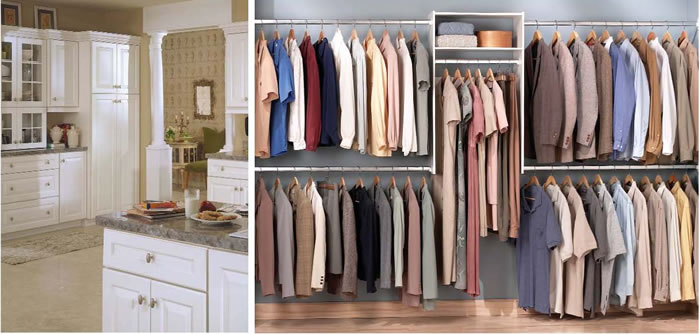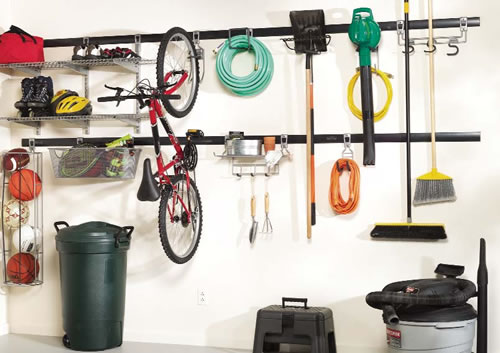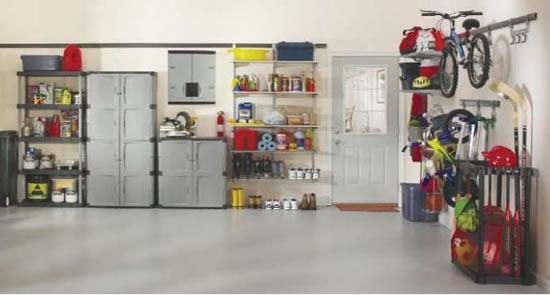Livability at a Glance™
StoringPlanning for Storing "Stuff"

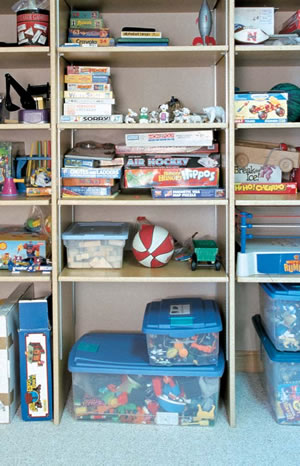
Have you ever met someone who had too much storage space in their home? It’s probably never happened. For many of us, the lack of space, disorganization, and clutter become significant sources of stress. In fact, according to published studies, Americans on average lose up to 150 hours every year looking for lost or misplaced items. Take control over your life and give yourself a little more time by addressing the storage opportunities of your home.
Linen Storage
One of the hallmarks of a well-thought-out home plan is linen storage. Typically located in or near bath areas, will the linen closets/cabinets be adequate for extra pillows, comforters, and sheet sets as well as towels and washcloths? So many linens are oversized: towels, bedding, blankets. You don’t want to have to default to using other bathroom storage, taking away from places for blow dryers and personal care items.
Bikes, lawnmowers, sporting goods, etc.
It’s no secret that garages are getting bigger, and today’s larger vehicles are only part of the reason why. Four bicycles, golf clubs, every kind of ball imaginable, skates, scooters—all in a pile—yuck! Adequate storage makes the mess go away. Today’s garage systems help organize your garage and your life by having a place for tools, gardening supplies, sporting goods, etc.
Sizable bedroom closets
“More closet space” is one of the most often mentioned reasons for buying a new home. Stuff multiplies, and we’re not sure how! But in addition to bigger closets, closet systems can help you organize and store twice as many items as the standard rod and shelf approach! Ventilated (wire) closet hanging systems have become very popular due to its flexibility and the ability for air to move between clothes and through shelving—keeping clothes fresher longer.
Games, holiday decorations
The day after Thanksgiving and it’s time for holiday decorations to come out. But, where are they? Mixed up with St. Patrick’s Day, Valentine’s Day, and Halloween! From Christmas trees and lights to board games, we want convenient places to keep our stuff. Storage solutions may include closets or unfinished areas of the home.
Kitchen storage
Table settings for twelve, pots and pans, the 36-cup coffee maker, a dozen cans of tuna, and gourmet cookbooks. Large families and packrats need lots of storage in the kitchen!
With the kitchen as the activity hub in most homes, more thought should go into storage and serving issues. Will items be stored convenient to where they will be used? What about big pots and pans? Or, pretty dishware and other items you would like to display? Pantry storage for prepared foods? Only you know how you want your kitchen to function, so talk with a kitchen cabinet specialist regarding products and solutions available to create your dream kitchen!
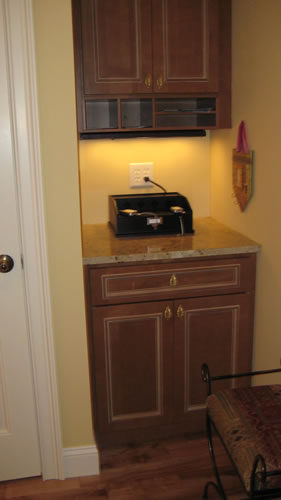
Drop Zone
Cell phones, keys, umbrellas, mail
A drop zone. Everybody needs one and everybody has one. It’s just that too many of us use a kitchen island, breakfast table, or other area that just happens to be convenient to drop off keys, pocket change, the mail, cell phones, etc.
Eliminate unsightly clutter by putting in a cabinet near the entry from the garage to organize these things. Be sure to incorporate a recharging center for cell phones and personal devices. You may also want to add a tall space for hanging umbrellas, and a cork board or write-on board to turn this into a message center. Stress-free living includes knowing you’ll never lose your keys again and where your fully charged cell phone is when you leave the house!
Long-term storage
Johnny’s history is often in a box—baby clothes, baptism, first day of school, birthday cards, a brilliant essay, all kinds of awards. Until Johnny is old enough to take them off your hands, you have a storage challenge!
Items with tremendous personal value but infrequently accessed need dry, long-term storage. Garage storage or unfinished areas of the home can be ideal long-term storage spots. Be sure to use the right kind of containers—as cardboard boxes can deteriorate and contribute to a musty basement smell.
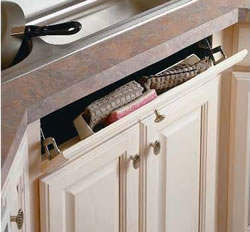
Photo Courtesy of Rubbermaid
Bulk items/Cleaning supplies
We all love a good bargain, but where do you keep the jumbo 12-roll pack of paper towels? Or cleaning supplies, some of which need to be stored out of the reach of children? Ideally you would like to keep these items close to where they will be used. Convenient to the kitchen, a walk-in coat closet off the garage entry offers shelving for such items while in the laundry room, a broom closet and generous cabinetry offer plenty of additional storage.
Everyday coats, shoes, boots, etc.
If you live in a cold winter climate, have a larger family, or entertain frequently, you’ll appreciate adequate coat storage easily accessed from the front door, garage entry, or both. Nothing is more stressful than getting the family out the door with everything they need, on time in the morning. If you have lockers near the garage entry, that’s where the kids will find their lunch boxes (or lunch money), backpacks, gym clothes, etc.
Garage Storage
Today’s garages are so much more than simply a place where cars are kept. As with homes overall, garages have become larger and are serving more purposes. In addition to auto supplies, garages are ‘home’ to lawn and garden products, tools, sports equipment, wintertime products, paint, and much more.
If, when parked in the garage, your daily commute to your car weaves around bikes, steps over garden tools, and dodges dodge balls, you’re not alone. In fact, the stress associated with this reality has given rise to garage storage and organization systems becoming one of the hottest markets in both new construction and remodeling. The promise of a neat, tidy, organized garage is compelling both rationally and emotionally.
Whether you are building a new home or looking to reorganize the garage of your existing home, the first step is to identify any activity zones, such as a workbench or a gardening center, as these may dictate specialized storage needs. Second, determine what you really want to keep in the garage. With an existing home, that means throwing some stuff away! Be prepared – you just may need to rent a dumpster for all that stuff that’s been collecting in your garage.
Knowing the activity zones and items that will be stored in the garage is the first step in designing your storage solution. With blueprints (or garage measurements) in hand, identify spaces along the walls that don’t interfere with opening the doors on your cars or walkways into the house. Sometimes there are also storage opportunities between parked vehicles or even overhead if your garage has a high ceiling.
Since keeping the garage reasonably clean is important from many perspectives (including safety, pest control, and overall appearance), you’ll want to get most items up and off the floor. Various garage wall storage systems are available, offering hanging for tools, shelving, cabinetry, and sporting goods storage options. Mobile storage—wheeled storage cabinets for example—address the same need as these units are easily moved to clean around.
The choice of open shelving vs. cabinet storage often comes down to aesthetics, personal preference, and price. But another consideration should be child safety. Sharp or dangerous items (pesticides, for example) are best kept in cabinets concealed from curious eyes. Optimally, these cabinets would be lockable.
Sporting goods, particularly bicycles, present their own challenges. With an active family, these frequently used items need to be readily available. But what do you do with four bikes? Garage organization suppliers offer numerous solutions that help store bikes out of the way, many times off the floor, yet are easily accessible. The far end of the garage (when parked, the wall closest to your car’s front bumper) offers a special storage opportunity, particularly for less frequently needed and larger items. Deep cabinets can be mounted high enough on the wall so that when you pull your car in, the hood clears underneath these cabinets.
Also, many innovative overhead storage products are becoming available. These solutions are ideal for seasonal storage (where you store the Christmas lights and decorations for the other eleven months). At the same time, you must consider safe accessibility. Climbing ladders to retrieve heavy or bulky items is obviously unwise. Though not strictly storage, one final issue merits its own consideration—those who spend a lot of time in the garage pursuing hobbies or even watching TV while playing cards. If that’s you, don’t overlook heating (keeping your favorite space usable year-round); refrigeration (cold beverages); and even where to put the cable TV jack.
Knowing the activity zones and items which will be stored in the garage is the first step in designing your storage solution. With blueprints (or garage measurements) in hand, identify spaces along the walls which don’t interfere with opening the doors on your cars or walkways into the house. Sometimes there are also storage opportunities between parked vehicles or even overhead if your garage has a high ceiling.
Since keeping the garage reasonably clean is important from many perspectives (including safety, pest control and overall appearance,) you’ll want to get most items up and off the floor. Various garage wall storage systems are available, offering hanging for tools, shelving, cabinetry, and sporting goods storage options. Mobile storage—wheeled storage cabinets for example—address the same need as these units are easily moved to clean around.
The choice of open shelving vs. cabinet storage is often comes down to aesthetics, personal preference and price. But another consideration should be child safety. Sharp or dangerous items (pesticides, for example) are best kept in cabinets concealed from curious eyes. Optimally, these cabinets would be lockable.
Sporting goods, particularly bicycles, present their own challenges. With an active family, these frequently used items need to be readily available. But what do you do with four bikes? Garage organization suppliers offer numerous solutions which help store bikes out of the way, many times off the floor, yet are easily accessible. The far end of the garage (when parked, the wall closest to your car’s front bumper) offers a specia
storage opportunity, particularly for less frequently needed and larger items. Deep cabinets can be mounted high enough on the wall so that when you pull your car in, the hood clears underneath these cabinets.
Also, many innovative overhead storage products are becoming available. These solutions are ideal for seasonal storage (where do you store the Christmas lights and decorations for the other eleven months?) At the same time, you must consider safe accessibility. Climbing ladders to retrieve heavy or bulky items is obviously unwise. Though not strictly storage, one final issue merits its own consideration—guys who spend a lot of time in the garage pursuing hobbies or even watching TV while playing cards. If that’s you, don’t overlook heating (keeping your favorite space usable year-round); refrigeration (cold beverages, not frozen beverages); and even where to put the cable TV jack.
Read more about Garage Storage here.
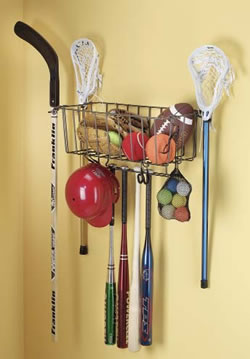
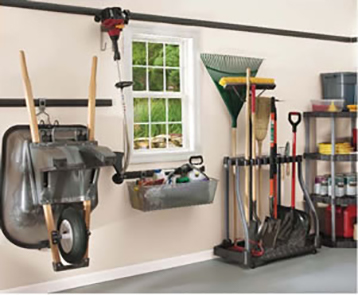
One final tip if you are going to install a garage storage system in your present home
After the dumpster is hauled away, you just might want to rent a storage unit to store everything else from your garage during the installation of your new storage system! Garage storage and organization systems are an excellent investment for your own sanity and peace of mind. They may also be an amenity that helps you someday resell your home for a higher price and in a quicker timeframe. You’ll never regret spending a little extra time carefully planning this aspect of your home!

